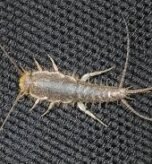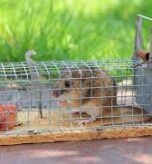When you find a tiny, scuttling insect in your home, one unsettling question often comes to mind: “Is this a baby cockroach?” The presence of these small pests, known as nymphs, is more than just a nuisance. It is a critical sign of a larger, hidden infestation. Nymphs rarely travel far from their nest, which means a colony is likely thriving nearby. This guide will help you accurately identify a baby cockroach, understand the associated health risks, and implement effective strategies for control and prevention.
What Does a Baby Cockroach Look Like?
Accurate identification of a baby cockroach, or nymph, is the first step in tackling an infestation. While they share some general traits, different species have unique characteristics.
General Characteristics of Nymphs
Baby cockroaches are small, with oval-shaped, flattened bodies. Their color ranges from light to dark brown. A key feature is their lack of fully developed wings, which only appear in adulthood. They have long, thread-like antennae and six spiny legs that allow them to move quickly. Newly hatched nymphs might look white or gray but darken after their first molt.
Identifying Common Cockroach Species
Recognizing the specific species is vital for choosing the most effective treatment.
- Baby German Cockroaches: These are the most common indoor cockroaches. Nymphs are tiny, about 1/8 inch long, and can be dark brown to black. As they grow, they turn light brown and develop two dark stripes on the pronotum (the area behind their head). They thrive in warm, humid places like kitchens and bathrooms.
- Baby American Cockroaches: These nymphs are larger, starting at 1/4 inch. They turn a reddish-brown color as they mature and have a distinct pale “halo” marking behind their head. You can find them in damp areas like basements, sewers, and around pipes.
- Baby Brown-banded Cockroaches: These small nymphs measure about 1/8 inch. They have two light-colored bands across their dark brown bodies. Unlike other species, they can live in drier areas like living rooms or behind picture frames.
- They prefer cool, dark, and damp locations like basements and drains. They are particularly unsanitary because they feed on garbage.
- Baby Smokybrown Cockroaches: These nymphs are similar in size to American cockroach nymphs but are darker. You can often find them in secluded spots like attics or garages.
Insects Often Mistaken for a Baby Cockroach
Correctly identifying the pest is crucial for proper treatment. People often confuse several insects with a baby cockroach:
- Bed Bugs: These pests are flat, oval, and found in mattresses or couches where they feed on blood. They have short antennae, unlike the long antennae of a baby cockroach.
- Crickets: Crickets have long hind legs for jumping, are lighter in color, and make a distinctive chirping sound.
- Beetles: Beetles have a hard, shell-like exoskeleton and are usually found outdoors.
- True Water Bugs: While people often call cockroaches “water bugs,” true water bugs are larger, have paddle-like legs, and live near outdoor water sources.
The Hidden Dangers of Cockroaches
Cockroaches are more than just creepy pests; they pose significant health risks.
They Spread Germs and Pathogens
Both adult and baby cockroaches carry pathogens like E. coli and salmonella. German cockroaches are notorious for spreading bacteria that lead to severe foodborne illnesses. Their droppings can contaminate food storage areas, making even a small infestation a health hazard.
They Trigger Allergies and Asthma
Cockroach droppings, shed skins, and saliva release particles into the air that act as potent allergens. For people with asthma, especially children, exposure to these allergens can worsen symptoms and lead to hospital visits.
Taking Action: A Guide to Cockroach Control
Addressing a cockroach infestation requires a methodical and persistent approach.
Embrace Integrated Pest Management (IPM)
IPM is a holistic strategy that combines multiple techniques for long-term control while minimizing pesticide use. It focuses on understanding the pest’s behavior to manage it effectively.
Prevention Through Sanitation
Cleanliness is the most critical factor in preventing cockroach problems.
- Thorough Cleaning: Regularly wipe surfaces, vacuum crevices, and clean behind appliances to eliminate food sources.
- Proper Food Storage: Store all food, including pet food, in sealed, airtight containers.
- Waste Management: Dispose of garbage regularly in sealed bins.
- Moisture Reduction: Promptly repair any leaky pipes or faucets. Keep kitchens, bathrooms, and basements dry.
- Eliminate Clutter: Reduce clutter, especially cardboard boxes, as they provide ideal hiding spots.
- Seal Entry Points: Use caulk to seal cracks and gaps around windows, doors, pipes, and foundations to block entry.
Targeted Treatment Methods
While sanitation is key, you may need insecticides for established infestations.
- Baits (Gels & Stations): These are highly effective. Place small dabs of gel bait or plastic bait stations near hiding spots. The bait works slowly, allowing roaches to transfer the poison to others in the nest.
- Insect Growth Regulators (IGRs): These products disrupt the cockroach life cycle by preventing nymphs from becoming reproductive adults.
- Dusts (Boric Acid, Diatomaceous Earth): Apply a fine layer of dust in dry, inaccessible areas like wall voids or under appliances. These kill roaches by damaging their exoskeleton.
- Monitoring Traps: Use sticky traps to locate nests, assess the size of the infestation, and check if your treatments are working.
- Vacuuming: A powerful vacuum can effectively remove roaches, egg cases, and droppings. Dispose of the bag immediately.
Why You Should Avoid “Bug Bombs”
Total-release foggers, or “bug bombs,” are generally ineffective. They do not penetrate the cracks where cockroaches hide and can scatter them deeper into your walls, making the problem worse.
When to Call a Professional Exterminator
For severe or persistent infestations, especially those involving German cockroaches, professional help is the best option. Exterminators offer targeted, safe, and long-lasting solutions. They can create a customized treatment plan using IPM techniques to ensure comprehensive control.
Conclusion: Taking Back Your Home
Finding a baby cockroach is a clear warning sign that requires immediate action. By understanding their appearance, the serious health risks they pose, and effective control methods, you can maintain a pest-free home. Diligent sanitation, moisture control, and strategic sealing are your first lines of defense. For challenging infestations, a professional can provide the expertise needed to restore safety and peace of mind to your living space.



